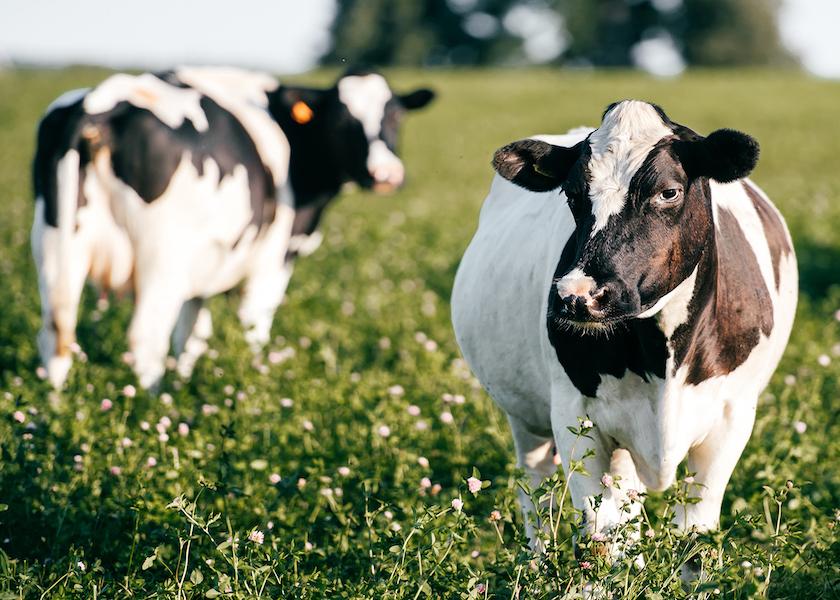5 Ways To Address Heat Stress And Keep Cows Cool

If high temperatures aren't affecting your dairy clients' herds yet--they will at some point.
The resulting heat stress can reduce cow productivity, increase mortality, affect milk quality and impact overall health, according to Lance Baumgard, Ph.D., professor at Iowa State University.
He reports that heat stress in the U.S. costs the dairy industry $1.7 billion annually.
The combination of costs and impact on dairy cattle well-being are why Baumgard says that during times of high temperatures he believes, “Heat stress abatement should be your biggest priority.”
But at what point do dairy cows experience heat stress? As a general rule, it’s at about 72°F with 50% humidity, according to Joe Armstrong, DVM, Extension cattle production systems educator and
Kevin Janni, Extension bioproducts and biosystems engineer, University of Minnesota.
Furthermore, high-producing cows eat more and generate even more heat, Armstrong and Janni add. They say such cows can begin to experience heat stress in well-ventilated barns at air temperatures as low as 65°F.
Evaluate Environments
While you can’t control Mother Nature, you can help dairy producers keep cows more comfortable and, as a result, more productive than they might be otherwise.
Baumgard says one of the best ways to alleviate the negative consequences of heat stress is by physically modifying the animal’s environment.
“Priorities should be made to reduce solar radiation and secondly, increase evaporative heat loss in conjunction with it by using fans,” he says in a webinar sponsored by Balchem Animal Nutrition and Health.
Here are five practices to consider for addressing heat stress:
1. Keep an eye on body temperatures. Normal body temperature for an adult cow is 101.5 to 102.5 degrees °F, according to Armstrong and Janni. They say if more than 5% to 10% of cows have a body temperature above 105 degrees °F, the situation is considered an emergency and immediate action should be taken.
2. Be prepared to provide more water. The traditional recommendation is to provide one water source per 20 head. This may not be enough during high temperatures.
Cows need to increase water intake during times of heat stress to dissipate heat through respiration and by sweating, according to Washington State University (WSU) College of Veterinary Medicine. (Learn more at https://bit.ly/3xkkmvh)
Water consumption will increase by as much as 50% in high temperature periods, WSU veterinarians report. A 1,400 lb. cow producing 65 lb. of milk at 3% butterfat needs at least 32 gallons of water per day at 80 degrees °F, according to WSU veterinarians. The same cow needs at least 36 gallons of water at 90 degrees °F.
If water supplies are not adequate or heat stress becomes severe, cows divert water normally used in milk synthesis to the processes of heat dissipation. Water intake will rise by 5 to 6 gallons on summer days due to temperature effects alone.
3. Avoid vaccinations during hot weather periods. Consider other routine practices or medical procedures that can minimize the amount of stress cattle are experiencing, adds Baumgard.
4. Evaluate feedstuffs and feeding timing. Dry matter intake can decrease by 0.17 pounds for each degree above 68 °F, according to Alvaro Garcia, a former South Dakota State University Extension program director. During severe heat stress, total intake and milk production may decrease by more than 25%. He estimates that for every 1 lb. decrease in dry matter intake 2 lbs. of milk production are lost.
WSU recommends increasing feeding frequency (an extra feeding or two), feeding at a cooler time of day, or even changing the ration. Summer rations will require a buffer and better forage quality.
5. Provide maximum shade in housing areas and holding pens for lactating and dry animals. WSU says to help dairy producers answer the three following questions: Are shade structures sited North-South? Are freestall barns sited East-West? Are cows getting at least 25 to 50 square feet of shade space per animal? Make adjustments based on producers’ feedback, as possible
Predictions For The Future
Baumgard anticipates the issue of heat stress will worsen in the future, thanks to climate change.
Even if climate change isn’t a factor, he says heat stress will continue to be a more significant problem because of the genetic selection process underway in the dairy industry.
“Phenotypes economically important to us – like milk synthesis, lean tissue, etc. – are all heat-producing processes,” he says. “The likelihood of our grandchildren's farm animals producing more heat than our current animals is almost certain.”
That means the temperature at which a high-producing animal becomes heat stressed is going to continue to go down.
“So, we have to figure out what's going on and try to understand the biology of heat, so we can implement mitigation strategies,” he says.
SUMMARY RECOMMENDATIONS
Here are seven ways to help relieve lactating and dry cows during high temperatures:
1. Make water readily available
2. Provide shade
3. Use evaporative cooling
4. Install fans
5. Reduce walking distance to the parlor
6. Limit time in the holding pen
7. Improve ventilation
WHERE TO COOL COWS
Any areas where animals reside or pass through are potential candidates for cooling. Here are seven recommendations:
1. Tie-stalls, free stalls or dry lot pens
2. Holding pen
3. Maternity pen
4. Parlor exit lane
5. Feed lines/feed alleys
6. Feed bunks
7. Pre-fresh barn







